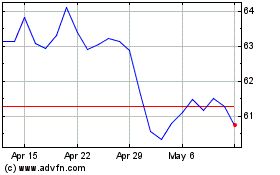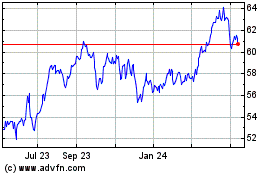iShares, the world’s largest provider of ETFs, is fast
approaching 300 total funds in the U.S. market. This is largely
thanks to the firm’s solid product development pace in the second
and third quarters, as the company has launched a series of ETFs
targeting equity-factors, as well as corporate bonds.
The latest addition from iShares is in the commodity world with
the Dow Jones UBS Roll Select Commodity ETF
(CMDT). This is actually the first commodity-focused ETF
for iShares since 2006, so undoubtedly expectations will be high
for this product, as the company hasn’t really shown much interest
in commodities as of late (see Inside the New Quality ETF from
iShares).
It is also worth noting that this ETF looks to go beyond some of
the original funds in the commodity space and will focus on
contango and backwardation in order to select contracts. Hopefully,
this process will assist in producing some outperformance for this
ETF, or at least help in keeping roll costs at a minimum.
For investors interested by another iShares foray into the
commodity world, we have highlighted some of the key details
regarding this recent launch below:
CMDT in Focus
The ETF looks to track the Dow Jones-UBS Roll Select Commodity
Index Total Return, a benchmark that holds 22 commodity futures
contracts. The index seeks to minimize the cost of rolling each
contract, and looks to include commodities from each of the six
major groups; energy, grains, industrial metals, precious metals,
softs, and livestock (read 2 Commodity ETFs Offering Investors
Sweet Returns).
The fund looks to minimize rolling costs by focusing on futures
contracts that have the least amount of contango or the most
backwardation. This is done by selecting contracts based on
observed contango and backwardation levels that are within 273
calendar days until expiration, and then choosing the most
favorable.
As a refresher, contracts with backwardation are priced lower
than those with nearer delivery months, while those with contango
are priced higher than those with nearer delivery months. So when
contango is seen, and investors roll from one contract to the next,
losses can accumulate making it difficult to see solid commodity
returns.
In terms of commodity sector weights for the index, energy takes
the top spot at nearly 40% of the total, followed by grains
(20.5%), industrial metals (16.1%), and precious metals (12.2%).
Softs and livestock, (respectively at 8.2% and 5.5%) round out the
rest of the portfolio, suggesting a heavy concentration in energy
commodities.
For individual holdings, natural gas takes the top spot at
roughly 13.2% of the portfolio, followed by crude oil at 10.8%.
Rounding out the top four are gold (9.4%) and copper (6.7%), while
Brent crude, corn and soybeans comprise the rest of the top seven
(also see the full list of Top ETFs).
For this exposure, the ETF charges investors 75 basis points in
fees, putting it just below the average for commodity ETF
expenses.
How does it fit in a portfolio?
This product could be a good choice for investors seeking broad
commodity exposure across all six of the major sectors. It may be
an especially solid pick for investors who desire some level of
contango fighting exposure in their commodity portfolios, as this
may lead to outperformance when compared to some ‘traditional’
products.
This fund may not be a good pick for those that are looking for
very spread out exposure across the various commodities, as energy
and grains make up a huge chunk of assets, while individual
commodities receive very large weights as well. Additionally, due
to competition and since the fund just launched, trading volumes
might be rather low to begin with for this commodity ETF, so bid
ask spreads might be a bit wide.
ETF Competition
For investors seeking other broad commodity ETFs, there are
plenty on the market. Broad competitors seem likely to include
DBC from PowerShares and GSG from
iShares, both of which have more than one billion in assets under
management.
However, in terms of contango fighting products, investors also
have USCI from United States Commodity Funds. This
product, which has half a billion in assets, also looks to avoid
contango issues, though it does so by only selecting commodities
that have the most backwardation, or at least the lowest levels of
contango (see Is USCI The Best Commodity ETF?).
This can result in a very concentrated portfolio, as
agricultural commodities make up over two-fifths of the assets,
followed by a 30% allocation to energy. Plus, only 14 commodities
are included in the ETF at any one time.
Given this, and the fund’s much higher expense ratio, CMDT could
find a way to accumulate some assets in the space. The new iShares
fund will have to show some outperformance above and beyond USCI
first though, as the commodity ETF world is rife with competition
and investors are certainly not starved for choice in this corner
of the market.
Want the latest recommendations from Zacks Investment Research?
Today, you can download 7 Best Stocks for the Next 30
Days. Click to get this free report >>
PWRSH-DB COMDTY (DBC): ETF Research Reports
ISHARS-SP G-CMD (GSG): ETF Research Reports
US-COMMODITY IF (USCI): ETF Research Reports
To read this article on Zacks.com click here.
Zacks Investment Research
Want the latest recommendations from Zacks Investment Research?
Today, you can download 7 Best Stocks for the Next 30 Days. Click
to get this free report
United States Commodity (AMEX:USCI)
Historical Stock Chart
From Mar 2024 to Apr 2024

United States Commodity (AMEX:USCI)
Historical Stock Chart
From Apr 2023 to Apr 2024
